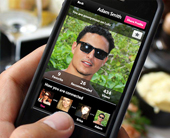A PwC’s survey of Global CEOs found that despite 74 percent of respondents expecting to grow their operations in the next 12 months; only 13 percent currently have key operations in Africa. There is ample opportunity for brands to be pioneers in the market.

According to the World Bank, Sub-Saharan Africa’s GDP is estimated to reach 5.2 percent in 2014, while global growth is estimated to rise by 3.7 percent. The International Monetary Fund (IMF) reports that out of the 20 countries with the highest expected GDP growth in 2014, nine are from Sub-Saharan Africa, with Sierra Leon’s GDP projected to reach 13.04 percent by the end of the year.
Economic growth in the region is fueled by mobile tech: The Ericsson Consumer Lab forecasts that by the end of 2014, “there will be over 635 million [mobile] subscriptions in Sub-Saharan Africa. This is predicted to rise to around 930 million by the end of 2019.”
Africans are using mobile technology to optimize markets, to improve health care, and to voice their opinions. It is not surprising that Africa’s top two most valued brands are MTN, a South African telecom service company, and Vodacom, South Africa’s largest mobile operator by subscriber numbers. In fact, MTN is the only African brand to make it to the top 100 list of MillwardBrown’s BrandZ tracker.
Big tech brands (like Google, Nokia, Samsung, IBM, Microsoft and Intel) are not wasting time, bringing more products to market and building research facilities in Africa. In a recent post for the Stanford Social Innovation Review, Erik Hersman, co-founder of Ushahidi and founder of iHub -an Innovation hub and hacker space for the technology community in Nairobi-, explained that “big tech companies [are] viewing Africa as the last blue ocean of consumer demand for technology.”

African consumers are tired of being misrepresented and are using mobile technologies and social media to speak up about product performance, customer service, and advertising.
Take the example of Kenyans on Twitter (#KOT). During the 2013 attacks at Westgate Mall in Nairobi, #KOT denounced CNN with the hashtag #someoneTellCNN for reports showing Kenya as a nation in chaos while they were suffering a terrorist attack.
The Mo Ibrahim Foundation reports that in 2013, “Sixty-eight percent of Twitter users in Africa relied on the platform as a primary source of information on national news.”
Strategy
When developing a strategy for Africa, it’s important to consider that: 1) word of mouth (empowered by mobile) is the predominant way of communication, and 2) market research in the continent is very limited, making it extremely important to learn about the aspirations of local communities when designing your strategy.
Since many common products are new for local markets, word of mouth — both in person and through mobile platforms — will help brands provide customers with stories to tell about their products, and will give these brands the opportunity to educate consumers on how to use those products.
Gerhard Fritz, Divisional Manager for the Shoprite Group of companies, told PwC : “What works in other parts of the world may not work in Africa. People in Africa have a proud heritage; they don’t take kindly to others coming and telling them what to do. Our perspective is to think of every business as local.”
Building trust is especially important in an environment where shoppers maintain a strong brand consciousness. A 2012 McKinsey survey shows that 59 percent of African grocery shoppers are loyal to their favorite brands, compared to 38 percent who chose the cheapest offer.
 Educating customers about the use of new products will make or break your brand. In Nakumatt stores, for example, shoppers tried to put black mascara on their lips because they didn’t know what it was for. Now, according to the Financial Times, the chain is setting up “free nail bars and makeovers to spread the word and tempt new customers for more expensive western brands entering the market, including Revlon and L’Oréal’s Maybelline.”
Educating customers about the use of new products will make or break your brand. In Nakumatt stores, for example, shoppers tried to put black mascara on their lips because they didn’t know what it was for. Now, according to the Financial Times, the chain is setting up “free nail bars and makeovers to spread the word and tempt new customers for more expensive western brands entering the market, including Revlon and L’Oréal’s Maybelline.”
Understanding how locals are using products will give you clues on how to market to them. Think about the contrasts that are part of the daily life of your customers: from fetching water for their households, to actively using mobile phones to get livestock price updates.
Brands entering or repositioning in Africa will need to pioneer market research efforts in the continent; understand how Africans use mobile technologies and embrace these technologies as part of their strategy; and earn the trust of African customers.
Their strategies should be both global yet hyper-local, and consider partnerships with established brands which will share knowledge of distribution channels and influencers, and how to participate in informal economies.
BY GABRIELA TORRES PATIÑO





 o purchase that “must-have” piece in the window, from the window, via touchscreens. And shoppers could schedule that item to be delivered within one hour anywhere in the City (e.g. a last minute present delivered to a party you have to miss, that anniversary gift you forgot to buy for your wife… again).
o purchase that “must-have” piece in the window, from the window, via touchscreens. And shoppers could schedule that item to be delivered within one hour anywhere in the City (e.g. a last minute present delivered to a party you have to miss, that anniversary gift you forgot to buy for your wife… again).
